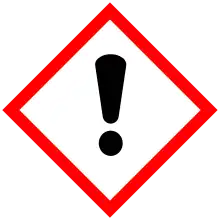| Names | |
|---|---|
| IUPAC name
samarium(III) bromide | |
| Other names
samarium tribromide tribromosamarium | |
| Identifiers | |
3D model (JSmol) |
|
| ChemSpider | |
| ECHA InfoCard | 100.033.938 |
| EC Number |
|
PubChem CID |
|
CompTox Dashboard (EPA) |
|
| |
| |
| Properties | |
| SmBr3 | |
| Molar mass | 390.07 g·mol−1 |
| Appearance | Light yellow solid[1][2] |
| Melting point | 700 °C (1,292 °F; 973 K)<[3] |
| +972.0·10−6 cm3/mol | |
| Hazards | |
| GHS labelling: | |
 | |
| Warning | |
| H315, H319, H335[3] | |
| P261, P305+P351+P338[3] | |
| Related compounds | |
Other anions |
Samarium(III) fluoride Samarium(III) chloride |
Other cations |
Samarium(II) bromide |
Except where otherwise noted, data are given for materials in their standard state (at 25 °C [77 °F], 100 kPa).
Infobox references | |
Samarium(III) bromide is a crystalline compound of one samarium and three bromine atoms with the chemical formula of SmBr3. Samarium(III) bromide is a dark brown powder at room temperature.[4] The compound has a crystal structure isotypic to that of plutonium(III) bromide.[5][6]
Preparation
SmBr3·6H2O can be crystallized by dissolving samarium oxide in 40% hydrobromic acid. The hydrate and ammonium bromide are heated in a vacuum to obtain the anhydrous form of samarium(III) bromide.[2]
Other compounds
Samarium(III) bromide forms some compounds with hydrazine, such as SmBr3·3N2H4·H2O which is a pale yellow needle-shaped crystal that is soluble in water and ethanol but insoluble in benzene, with d20 °C = 3.147 g/cm3.[7]
References
- ↑ Haynes, William M. (2016-06-24). CRC Handbook of Chemistry and Physics 97th Edition. CRC Press. pp. 4–83. ISBN 978-1-4987-5428-6.
- 1 2 林平娣, 吴国庆. 无水三溴化钐和三溴化镱的制备 Archived 2022-01-01 at the Wayback Machine[J]. 化学试剂, 1991(1):13-14.
- 1 2 3 "Samarium(III) bromide anhydrous, beads, −10 mesh, 99.99% | Sigma-Aldrich". www.sigmaaldrich.com. Retrieved 21 December 2016.
- ↑ Elements, American. "Samarium(III) Bromide Hexahydrate". American Elements. Retrieved 21 December 2016.
- ↑ Christoph Janiak, Hans-Jürgen Meyer, Dietrich Gudat, Ralf Alsfasser (2012). Riedel Moderne Anorganische Chemie. Walter de Gruyter. ISBN 978-3-11-024901-9.
{{cite book}}: CS1 maint: multiple names: authors list (link) - ↑ Wells, A. F. (1984). Structural Inorganic Chemistry (5th ed.). Oxford University Press. p. 421. ISBN 978-0-19-965763-6.
- ↑ Uchenye zapiski: Serii︠a︡ khimicheskikh nauk (SM Kirov adyna Azărbai̐jan Dȯvlăt Universiteti; 1977), page 37. Retrieved 14 March 2021.
This article is issued from Wikipedia. The text is licensed under Creative Commons - Attribution - Sharealike. Additional terms may apply for the media files.